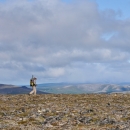Overview
The McKay's Bunting, a small songbird found only on the remote St. Matthew and Hall Islands in the Bering Sea, is facing a critical situation. Its population has been steadily declining, raising concerns about its future. Recent surveys from St. Matthew and Hall Island found the global population declined 38% from 2003 to 2018, equivalent to -3.2% loss per year. The decline is likely attributed to a complex interplay of factors, including: an increase in extreme weather events, predation from introduced species (red fox), and habitat loss and degradation. Additional monitoring surveys are needed to determine if the 38% decline in the McKay's Buntings global population is a short-term downward fluctuation in numbers, or part of an ongoing and longer-term decline of the species. The latter would be of particular concern because if the population continues to decline at this rate, and its breeding range contracts due to habitat degradation, it could further increase the species' risk of extinction.
Specifically, this project aims to address the following objectives:
- Whether the McKay’s Bunting global population continues to decline.
- The McKay’s Bunting breeding densities on Hall Island, and whether it is more stable than densities on St. Matthew.
- Whether their breeding range is contracting, and
- Their trends in habitat use across the islands.
Importance of this Work
Learning about the staggering decline of the McKay's Bunting can be a disheartening experience. It's natural to feel disheartened for this unique and beautiful songbird facing an uncertain future. However, it's important to remember that there is still hope, and individuals can still play a role in its recovery. By learning about the threats and subsequent declines facing McKay's Bunting and the ongoing efforts to conserve its population, you can transform your concern into action. Engaging in activities like supporting conservation organizations, advocating for responsible environmental practices, and spreading awareness can contribute meaningfully to the future of this uniquely Alaskan bird.
Actions WE ALL can take
While direct intervention on McKay’s Bunting breeding islands requires specialized expertise, individuals can still contribute meaningfully to its and other at-risk songbird species recovery by:
Participating in citizen science, like eBird: Anyone can contribute valuable data by submitting what they see to citizen science programs like eBird. McKay’s Buntings spend their winters along the western Alaska coastline from Kotzebue Sound to the Alaska Peninsula (Montgomerie and Lyon 2020) and sometimes stray outside their regular winter range to other parts of Alaska. Any sighting of them is valuable data point for scientists. By submitting your bird sightings to eBird, you can play a crucial role in monitoring its population.
Spreading the Word: Share information about the McKay’s Bunting with your family, friends, and neighbors. Talk to them about the importance of habitat protection, supporting science and bird conservation, and that sustained public support is crucial to ensure the future of this captivating Alaskan bird.



